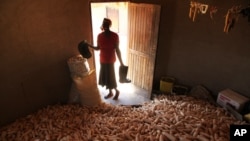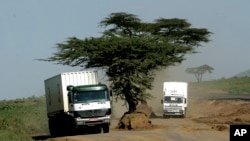YAOUNDE, CAMEROON —
A new day has just started and I am standing at one of the largest farm markets north of the Cameroon capital Yaounde. Trucks that have journeyed all night are off-loading their cargo of tomatoes, carrots, green beans, bananas, and an assortment of vegetables and grains. Some of the trucks are still loaded. I am told they will soon begin a daylong journey to the border, where traders from Gabon and Equatorial Guinea are waiting.
As I look around, it’s hard to believe that many people across the continent will go to bed on an empty stomach tonight. But the hard truth is that most of the world’s 800 million hungry people are in Africa. Why? The continent is throwing away $4 billion worth of grain annually due to what experts call massive post-harvest losses.
The hungriest continent
In spite of progress in food production, Africa is still the hungriest continent in the world. It accounts for the vast majority of nearly a billion people afflicted by food shortage globally. In the last 10 years, separate food crises have affected about 20 million people in the Sahel and in the Horn of Africa.
Campaigners for better policies say food shortage is becoming more frequent and affecting more people. One of them is Mamadou Biteye, the managing director of the regional office of the Rockefeller Foundation. Recently, I met him in Ethiopia, a country that became the rancorous symbol of Africa’s food problems in the 70s. Between 1983 and 1985, a treacherous famine killed about 400,000 people in the north of that country.
Biteye had been invited to Ethiopia by the African Media Initiative to rouse media interest in the continent’s food crisis. He told me there are many reasons why Africa cannot feed itself: In the 70s, draughts literally burned out the harvest in the Sahel. Today, climate change has rendered rainfall unpredictable, disrupting planting and harvest across the continent. Growing inequality means that many are stuck with subsistence. And, over the past decade, rising prices have put imported food above the reach of most of the continent’s poor.
Yet, Africa is throwing away a lot of its food. About 25 to 40 percent of the food produced on the continent is lost because of inadequate harvest, storage and transport practices. Market access has remained weak and very little food makes it up the value chain.
Biteye says if you tackle post-harvest loss, you nearly solve Africa’s food debacle. “Yearly grain loss is about 4 billion dollars and that is exactly the invoice that sub-Saharan Africa pays every year to import grains.
The lost food of Africa
“This means that if we are able to reduce this significantly, we don’t need to increase production.” And that would improve Africa’s environment, he said, agriculture wouldn’t need to use more land, water and chemicals to improve production.
In 2011, the World Bank and the Food and Agriculture Organization (FAO) estimated Africa’s lost food could feed at least 48 million people. In other terms, the report noted that food loss was greater than food aid received by the continent over the decade between 1998 and 2008.
The World Bank and FAO found that massive grain loss resulted from decay, pest destruction and physical scattering during harvest and transportation. Their report noted that loss could also be economical, in the form of the low prices of poor quality harvest.
Studies on post-harvest losses in Africa tend to focus on grain staples, which means the magnitude of the problem is grossly underestimated.
Looking at fresh produce losses
Fruits and vegetables are thought to be the hardest-hit victims of post-harvest loss. At the farm market in Yaounde, I can see why: Vegetables are stuffed in sacks and tightly packed in trucks; their leaves are already fading from dark green to yellow. Tomatoes are squeezed together in bamboo baskets. Bananas and plantains are flung to the ground and bruised. At the far end, a woman is sorting rotting potatoes for pig breeders. Most of the food here will not make it onto a plate.
Post-harvest loss has been going on in Africa for a long time. Traditional barns are exposed to pests, moisture and dirt. Bad roads make it difficult for most of the harvest to leave the farm. Manual harvesting makes the process slow and painful. In many parts of the continent, there is little or no post-harvest processing and preservation.
But it’s the global economic meltdown of 2010/2011 that drew attention to the problem. Since then, many solutions have been proposed. Some, like the need to industrialize and modernize the continent’s predominantly subsistence farming practices, have raised more debate than provided answers.
Need to work with smallholders
Critics say the promotion of agri-business could create new problems for the poor.
Biteye, who is cautiously optimistic about the prospects of agri-business, says an integrated approach is needed. “Eighty percent of the food produced in Africa is done by smallholder farmers and 80 percent of those are women.
“This is not a sector that can just be wiped out like that in the name of agribusiness. What we have seen as a phenomenon recently is land grabbing, massive acquisition of land by private companies.
“But I think this can be done in a way that does not drive smallholder farmers out of their lands. It can be done in collaboration with those smallholder farmers by building their capacity, collaborating with them to have access to irrigated land, quality agricultural inputs and improve their production both in quantity and quality, and put that into the value chain.
“This can be a win-win situation.”
Others solutions that are on the table are technological. Asian farmers have successfully used airtight bags, metallic silos and small-scale rice drying technologies to handle and process food for years.
A discussion currently going on is how to implement these ideas on the African continent. But for that to happen, those techniques have to be tested for adaptability. While that happens, millions somewhere on the continent will be going to bed hungry tonight. At the same time, tons of food would be thrown away somewhere on the continent.
As I look around, it’s hard to believe that many people across the continent will go to bed on an empty stomach tonight. But the hard truth is that most of the world’s 800 million hungry people are in Africa. Why? The continent is throwing away $4 billion worth of grain annually due to what experts call massive post-harvest losses.
The hungriest continent
In spite of progress in food production, Africa is still the hungriest continent in the world. It accounts for the vast majority of nearly a billion people afflicted by food shortage globally. In the last 10 years, separate food crises have affected about 20 million people in the Sahel and in the Horn of Africa.
Campaigners for better policies say food shortage is becoming more frequent and affecting more people. One of them is Mamadou Biteye, the managing director of the regional office of the Rockefeller Foundation. Recently, I met him in Ethiopia, a country that became the rancorous symbol of Africa’s food problems in the 70s. Between 1983 and 1985, a treacherous famine killed about 400,000 people in the north of that country.
Biteye had been invited to Ethiopia by the African Media Initiative to rouse media interest in the continent’s food crisis. He told me there are many reasons why Africa cannot feed itself: In the 70s, draughts literally burned out the harvest in the Sahel. Today, climate change has rendered rainfall unpredictable, disrupting planting and harvest across the continent. Growing inequality means that many are stuck with subsistence. And, over the past decade, rising prices have put imported food above the reach of most of the continent’s poor.
Yet, Africa is throwing away a lot of its food. About 25 to 40 percent of the food produced on the continent is lost because of inadequate harvest, storage and transport practices. Market access has remained weak and very little food makes it up the value chain.
Biteye says if you tackle post-harvest loss, you nearly solve Africa’s food debacle. “Yearly grain loss is about 4 billion dollars and that is exactly the invoice that sub-Saharan Africa pays every year to import grains.
The lost food of Africa
“This means that if we are able to reduce this significantly, we don’t need to increase production.” And that would improve Africa’s environment, he said, agriculture wouldn’t need to use more land, water and chemicals to improve production.
In 2011, the World Bank and the Food and Agriculture Organization (FAO) estimated Africa’s lost food could feed at least 48 million people. In other terms, the report noted that food loss was greater than food aid received by the continent over the decade between 1998 and 2008.
The World Bank and FAO found that massive grain loss resulted from decay, pest destruction and physical scattering during harvest and transportation. Their report noted that loss could also be economical, in the form of the low prices of poor quality harvest.
Studies on post-harvest losses in Africa tend to focus on grain staples, which means the magnitude of the problem is grossly underestimated.
Looking at fresh produce losses
Fruits and vegetables are thought to be the hardest-hit victims of post-harvest loss. At the farm market in Yaounde, I can see why: Vegetables are stuffed in sacks and tightly packed in trucks; their leaves are already fading from dark green to yellow. Tomatoes are squeezed together in bamboo baskets. Bananas and plantains are flung to the ground and bruised. At the far end, a woman is sorting rotting potatoes for pig breeders. Most of the food here will not make it onto a plate.
Post-harvest loss has been going on in Africa for a long time. Traditional barns are exposed to pests, moisture and dirt. Bad roads make it difficult for most of the harvest to leave the farm. Manual harvesting makes the process slow and painful. In many parts of the continent, there is little or no post-harvest processing and preservation.
But it’s the global economic meltdown of 2010/2011 that drew attention to the problem. Since then, many solutions have been proposed. Some, like the need to industrialize and modernize the continent’s predominantly subsistence farming practices, have raised more debate than provided answers.
Need to work with smallholders
Critics say the promotion of agri-business could create new problems for the poor.
Biteye, who is cautiously optimistic about the prospects of agri-business, says an integrated approach is needed. “Eighty percent of the food produced in Africa is done by smallholder farmers and 80 percent of those are women.
“This is not a sector that can just be wiped out like that in the name of agribusiness. What we have seen as a phenomenon recently is land grabbing, massive acquisition of land by private companies.
“But I think this can be done in a way that does not drive smallholder farmers out of their lands. It can be done in collaboration with those smallholder farmers by building their capacity, collaborating with them to have access to irrigated land, quality agricultural inputs and improve their production both in quantity and quality, and put that into the value chain.
“This can be a win-win situation.”
Others solutions that are on the table are technological. Asian farmers have successfully used airtight bags, metallic silos and small-scale rice drying technologies to handle and process food for years.
A discussion currently going on is how to implement these ideas on the African continent. But for that to happen, those techniques have to be tested for adaptability. While that happens, millions somewhere on the continent will be going to bed hungry tonight. At the same time, tons of food would be thrown away somewhere on the continent.







